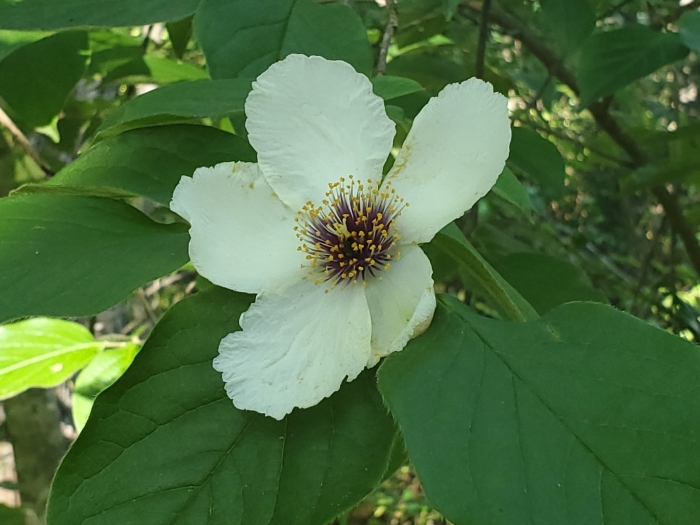Mountain Camellia
(Stewartia ovata)
Mountain Camellia (Stewartia ovata)
/
/

Craig Martin
Public Domain
Image By:
Craig Martin
Recorded By:
Copyright:
Public Domain
Copyright Notice:
Photo by: Craig Martin | License Type: Public Domain | License URL: http://creativecommons.org/publicdomain/zero/1.0/ | Rights Holder: Craig Martin | Publisher: iNaturalist | Date Created: 2021-06-26T17:43:02-07:00 |





























































Estimated Native Range
Summary
Stewartia ovata, commonly known as Mountain Camellia, is a deciduous flowering tree or shrub native to the understory of deciduous forests in the Southeastern United States, particularly in the Appalachian Mountains. It typically grows to about 5 meters (16 2/3 feet) tall and is noted for its smooth, exfoliating bark that reveals a tapestry of gray, orange, and brown hues. The leaves are oval, broad, and have finely serrated margins; they provide a stunning display of orange, red, or gold colors in the fall. The flowers, which resemble those of the related Camellia genus, are quite showy, measuring 6–12 cm (2.4–4.7 in) in diameter with five white petals and a center filled with numerous stamens that can be white, yellow, or purple. These blossoms make their appearance in early to mid-summer and are a highlight of the plant.
Mountain Camellia is valued for its ornamental bark, attractive foliage, and beautiful flowers. It is often used in woodland gardens, as a specimen plant, or in mixed borders. While it can adapt to full sun or part shade, it thrives best in a sheltered location with dappled light, mimicking its natural forest habitat. The plant prefers medium moisture, well-drained acidic soils, and benefits from a layer of mulch to maintain soil moisture. Although it is not commonly afflicted by serious pests or diseases, it can be susceptible to leaf spot and canker in poor conditions. Stewartia ovata is not known for aggressive roots or invasiveness, making it a well-behaved addition to the garden.CC BY-SA 4.0
Mountain Camellia is valued for its ornamental bark, attractive foliage, and beautiful flowers. It is often used in woodland gardens, as a specimen plant, or in mixed borders. While it can adapt to full sun or part shade, it thrives best in a sheltered location with dappled light, mimicking its natural forest habitat. The plant prefers medium moisture, well-drained acidic soils, and benefits from a layer of mulch to maintain soil moisture. Although it is not commonly afflicted by serious pests or diseases, it can be susceptible to leaf spot and canker in poor conditions. Stewartia ovata is not known for aggressive roots or invasiveness, making it a well-behaved addition to the garden.CC BY-SA 4.0
Plant Description
- Plant Type: Tree, Shrub
- Height: 10-15 feet
- Width: 10-15 feet
- Growth Rate: Slow
- Flower Color: White
- Flowering Season: Summer
- Leaf Retention: Deciduous
Growth Requirements
- Sun: Full Sun, Part Shade
- Water: Medium
- Drainage: Medium
Common Uses
Bee Garden, Border Plant, Butterfly Garden, Showy Flowers
Natural Habitat
Understory of deciduous forests in the Southeastern United States, particularly in the Appalachian Mountains
Other Names
Common Names: Mountain Stewartia, Mountain-Camellia, Amerikanische Scheinkamelie
Scientific Names: , Stewartia ovata, Stewartia pentagyna, Malachodendron pentagynum, Stewartia ovata var. grandiflora, Malachodendron ovatum, Stewartia ovata f. grandiflora, Malachodendron pentagynum var. grandiflorum, Malacodendron ovatum, Stewartia montana
GBIF Accepted Name: Stewartia ovata (Cav.) Weath.